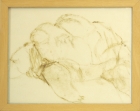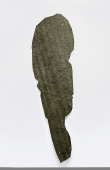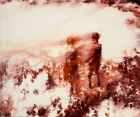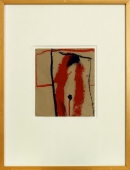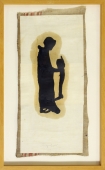The Shape of Freedom: International Abstraction after 1945
June 4 – September 25, 2022
Museum Barberini. Potsdam, Germany
PRESS RELEASE
On June 4, 2022, the exhibition The Shape of Freedom: International Abstraction after 1945 opens at the Museum Barberini. It focuses on the two most important currents of abstraction following World War II: Abstract Expressionism in the United States and Art Informel in western Europe. The Shape of Freedom is the first exhibition to explore this transatlantic dialogue in art from the mid-1940s to the end of the Cold War.
The show comprises around a hundred works by over fifty artists including Sam Francis, Helen Frankenthaler, K. O. Götz, Georges Mathieu, Lee Krasner, Ernst Wilhelm Nay, Mark Rothko, Jackson Pollock, Judit Reigl, and Clyfford Still. Works on loan come from over thirty international museums and private collections including the Kunstpalast Düsseldorf, the Tate Modern in London, the Museo nacional Thyssen-Bornemisza in Madrid, the Metropolitan Museum of Art and the Whitney Museum of American Art in New York, the Centre Pompidou in Paris, the Peggy Guggenheim Collection in Venice, and the National Gallery of Art in Washington, DC.
After its opening run in Potsdam, the exhibition will travel to the Albertina modern in Vienna and the Munchmuseet in Oslo.
The point of departure for the exhibition in the Museum Barberini is the Hasso Plattner Collection, which includes important works by Norman Bluhm, Sam Francis, and Joan Mitchell.
World War II was a turning point in the development of modern painting. The presence of exiled European avant-garde artists in America transformed New York into a center of modernism that rivaled Paris and set new artistic standards.
In the mid-1940s, a young generation of artists in both the United States and Europe turned their back on the dominant stylistic directions of the interwar years. Instead of figurative painting or geometric abstraction they embraced a gestural, expressive handling of form, color, and material—a radically experimental approach that transcended traditional conceptions of painting. Artists like Jackson Pollock, Lee Krasner, Willem de Kooning, Franz Kline, Hans Hofmann, and Joan Mitchell discovered an intersubjective form of expression in action painting, while the color field painting of Mark Rothko, Barnett Newman, Adolph Gottlieb, Robert Motherwell, and Clyfford Still presented viewers with an overwhelming visual experience.
Concurrently with Abstract Expressionism in the United States, artists in Paris and other European metropolises explored new materials, textures, and modes of composition. This new painterly approach was designated “Informel” due to its “formless,” unbridled aesthetic. Works by Georges Mathieu, Antoni Tàpies, Pierre Soulages, Wols, Jean Fautrier, and Jean Dubuffet marked a break with art historical tradition.
With artists such as K. O. Götz, Gerhard Hoehme, Bernard Schultze, Winfred Gaul, Ernst Wilhelm Nay, and Fritz Winter, West Germany likewise emerged as a center of European postwar abstraction from the mid-1950s on. As such, it cultivated close contacts with France and the United States. The exhibition documenta II in 1959 celebrated Art Informel and Abstract Expressionism as the manifestation of a new, universal visual language that would strengthen the political alliance of liberal western nations. In West Germany, adical abstraction was hailed as the new standard for avant-garde painting, in contrast to the Socialist Realism of East Germany or the aesthetic principles of the Nazi regime.
Abstract Expressionism in America and Art Informel in Europe have often been viewed as separate, independent developments—a geographical and cultural distinction that obscures the close connection between the two movements. The Shape of Freedom now highlights the intensity and enduring nature of this transatlantic exchange.
The exhibition also features works by lesser-known artists such as Jean Degottex, Simon Hantaï, Manolo Millares, Theodoros Stamos, and Jack Tworkov and foregrounds the long-ignored influence of women artists including Mary Abbott, Janice Biala, Natalia Dumitresco, Perle Fine, Helen Frankenthaler, Lee Krasner, Joan Mitchell, Judit Reigl, Deborah Remington, Janet Sobel, Hedda Sterne, and Maria Helena Vieira da Silva.
Ortrud Westheider, Director of the Museum Barberini, Potsdam:
“The paintings in the exhibition bear witness to the tremendous longing for artistic freedom that emerged on both sides of the Atlantic after 1945. The Hasso Plattner Collection, with important works by Norman Bluhm, Joan Mitchell, and Sam Francis, served as our point of departure. The concept developed by our curator Daniel Zamani was so convincing that the Albertina modern in Vienna and the Munchmuseet in Oslo agreed to host the exhibition as well. I am delighted to see this European cooperation.”
Angela Stief, Director of the Albertina modern, Vienna:
“Due to its location, Vienna was one of the central arenas of the Cold War. The exploration of artistic freedom and the possibilities for individual expression that arose on both sides of the Atlantic are more relevant than ever for us today. In Vienna, artists including Maria Lassnig, Arnulf Rainer, and the recently deceased Hermann Nitsch appear alongside figures such as Jackson Pollock, Mark Rothko, Joan Mitchell, and Helen Frankenthaler to show how these international developments were received in Austria. At the Albertina modern, particular emphasis is also placed on the women artists associated with postwar abstraction.”
Stein Olav Henrichsen, Director of the Munchmuseet, Oslo:
“Our museum’s new building, which opened last year in October, offers us wonderful opportunities to showcase the often large, visually overwhelming formats of abstract artists. We are already full of anticipation to be able to present these outstanding artistic positions to the people of Oslo and our numerous international guests in spring 2023. We are especially pleased to further expand our close collaboration with Museum Barberini on the Munch exhibition planned for 2023 with this additional exhibition project.”
The Shape of Freedom: International Abstraction after 1945
An exhibition of the Museum Barberini, Potsdam, the Albertina modern, Vienna, and the Munchmuseet, Oslo, curated by Daniel Zamani.
The exhibition is accompanied by a 256-page catalogue with essays by Jeremy Lewison, Gražina Subelyt?, and Daniel Zamani (Prestel, 2022, English/German). ISBN 978-3-7913-7947-0 & 978-3-7913-7948-7
With the generous support of the Fondation Gandur pour l’Art, Genève.
In Potsdam, the exhibition stands under the patronage of Her Excellency Amy Gutmann, Ambassador of the United States of America to Germany.
artist-info.com Exhibition Page
https://www.artist-info.com/exhibition/Museum-Barberini-Id389934

 Exhibition Announcements
Exhibition Announcements 












